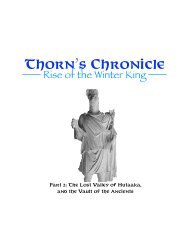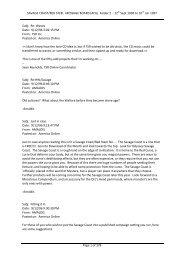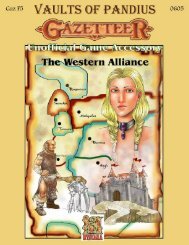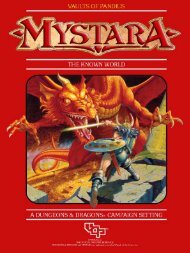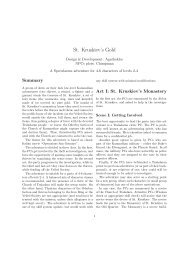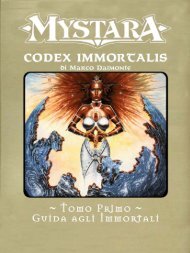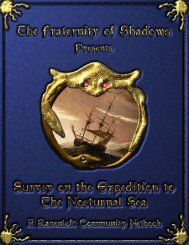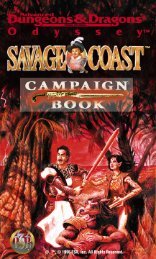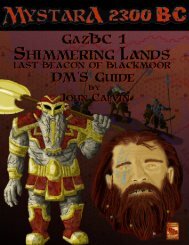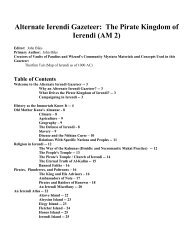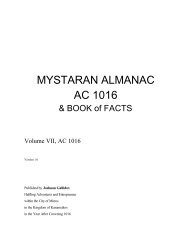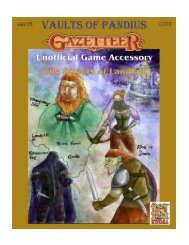Karameikos - Vaults of Pandius
Karameikos - Vaults of Pandius
Karameikos - Vaults of Pandius
You also want an ePaper? Increase the reach of your titles
YUMPU automatically turns print PDFs into web optimized ePapers that Google loves.
The Demography <strong>of</strong> <strong>Karameikos</strong>the ancient age. Their presence in<strong>Karameikos</strong> dates back to the Great BeastmenInvasion <strong>of</strong> BC 1000, when their ancestorsravaged the Traldar civilization and ultimatelycontributed to its decline. In the followingcenturies, gnoll numbers have occasionallybeen on the rise, but they never managed toovercome the Traladarans again and havebeen slowly reduced to mere bands and smalltribes scattered in <strong>Karameikos</strong>’ northernwilderness, forced to ally with otherhumanoids (orcs, usually) in order to survive.Gnoll bands, for example, are found in theHorned Heads orc tribe (in the northernAltan Tepes) and in the Rashak’s Reavers orctribe (another orc tribe stationed betweenFort Doom and Luln). Exceptions to this ruleare the Faceslashers tribe (who serve“Queen” Ilyeana Penhaligon at Haradraith’sKeep) and the powerful Death’s Head tribe,the last powerful gnoll tribe who controls theupper Foamfire valley and regularly threatensVerge and its surroundings. Individual gnollmercenaries can also be found in the service<strong>of</strong> some human (like the Black Eagle Baron)or humanoid villains.Ogres (pop. 1,400)Bands <strong>of</strong> common ogres (Homo monstrumbrutalis) came to <strong>Karameikos</strong> in theaftermath <strong>of</strong> the Battle <strong>of</strong> Sardal Pass (BC492). There are no known ogre tribes, asmost <strong>of</strong> the ogres live in family groupsscattered in the Cruth Lowlands region.Some <strong>of</strong> these groups have allied with localdominant orc tribes (like the Blackstone orthe Greyslayers). Elsewhere the ogrepresence is scarcer. They are mostly found asmercenaries among other humanoid tribes <strong>of</strong>the Black Peaks range (like the Death’s Headgnolls) and <strong>of</strong> eastern <strong>Karameikos</strong>.Wood Imps (pop. 1,000)These pesky evil creatures <strong>of</strong> the forestsgradually migrated to <strong>Karameikos</strong> fromAlfheim in the past centuries, spreading inthe land’s thick forests like the DymrakForest and the Radlebb Woods. The woodimp tribes are held at bay by the Vyalia andCallarii elven clans that inhabit the forestsand are seldom dangerous, but from time totime the imps manage to forge alliances withthe enemies <strong>of</strong> elves, like the goblin tribes orother monsters – and then they can becomea problem.Lupins (pop. 550)Small groups <strong>of</strong> lupins are scattered among<strong>Karameikos</strong>’ southern towns. They aremostly immigrants from other countries(Thyatis in particular, from where mostrecent immigrants in the Grand Duchycome), who live at the edges <strong>of</strong> humansociety. In inland villages lupins <strong>of</strong>ten haveto face the hatred <strong>of</strong> local Traladaranpeasants, to whom they recall memories <strong>of</strong>the beastmen <strong>of</strong> ancient legends or thewerewolves. That is why those lupins wholive in <strong>Karameikos</strong>’ interior tend to stayalone in the wilderness, away from humanpresence. However, most lupins in<strong>Karameikos</strong> prefer to stick to morecosmopolitan settlements, like the cities andtowns. Karameikan lupins are mostlymongrels (30%), while represented breedsinclude the wolvenfolk (20%), who wanderthe woods and the wilderness, away fromcurious eyes, and a clan <strong>of</strong> Cimarron hairless(30%) who lives together with the HairlessDog orc tribe <strong>of</strong> the southern Altan Tepes.Minor breeds encountered in <strong>Karameikos</strong>are the great beagles (10%) and the shagheads(10%).24THRESHOLD: The Mystara Magazine Issue #1



